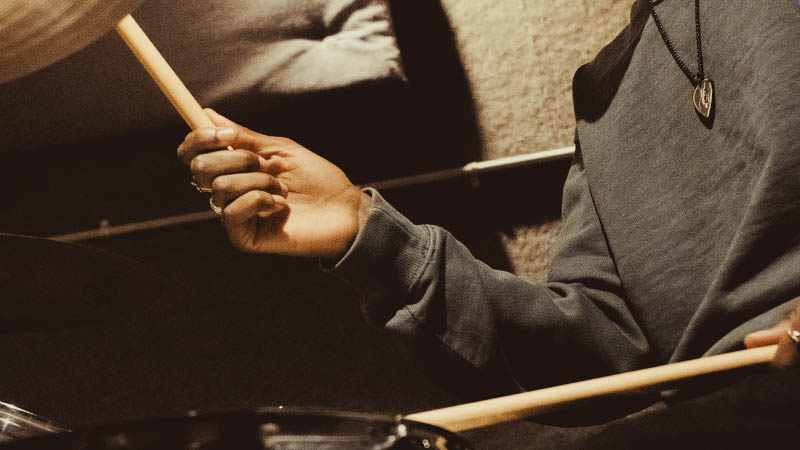
At Southbury Music, we’ve guided many young Connecticut musicians through their instrumental journey. As you learn to play the drums, we’re glad to share these tips. We’re confident they’ll help you embrace the “Beginning Dummers” path ahead! We look forward to helping you reach the point where you’re ready to become the heartbeat of a rock band. In fact, you might even want to check out our “Rock Band Camp” during the summer!
1) Drumming is Fun When Done Right
The first and most important thing to remember is that drumming is fun, when it’s right! Even when you’re practicing the basics, if you feel the rhythm and love to drum, you can have a good time. If you’re not having fun at any given time, let us make some suggestions:
If you have music playing to drum with, try songs that have the same BPM (beats per minute) as your practice.
Try practicing with friends. Sometimes simply focusing on the teamwork of drumming will help a beginner keep pace. This alone can also add to the fun.
Remember to take a break and just rock out. A little free-form drumming can remind you why you love to drum before getting back to the fundamentals.
This is one of our favorite old-school hacks. A metronome will help you learn how to become the rock-solid beat for a band.
Each of these techniques can help to make sure your drumming practice is always fun. Because, let’s face it, drumming is just a fun thing to do.
2) This is Gonna Be Loud: Prepare Your Family
If you already have a drum kit at home, practicing with it will be loud. It takes time to learn to drum softly, and at first, you’re just focusing on getting your hands and feet to follow your thoughts and drum-in-time. Like most instrument practice, it’s important to accept that a little noise is part of the process. Not only will you need to be personally prepared for the volume of a drum kit, you’ll also want to prepare your family.
Choose times for practice when you are least likely to interrupt others. Don’t practice on acoustic drums really late into the night and choose daytime hours when you have the house to yourself or when your family is engaged in their own noisy activities – like lawn work.
3) Use a Drum Pad or Electric Drum Kit
The solution to noise, especially if you want to practice during quiet hours, is a drum pad or electric drum kit. Every drummer should have a drum pad – a foam-covered panel where you can practice rudiments and rhythms without using the kit. Modern electric drum kits are also very much like drum pads when you don’t connect them to speakers (or turn the volume low). They are essentially drum pads with sensors that convey your hits through speakers instead of acoustic drumheads. Electric drum kits also span an affordable price range, especially for young players
4) Make Time for Practice – Carry Your Sticks
When it comes to the drums, you are training both your mind and body. It’s a lot like learning a sport. Remember, you’re not just learning the numeric principles of music and rhythm. Practice helps you build muscle and stamina to play longer. Practice helps you train your coordination so your hands and feet work together to create amazing and complex rhythms. Practice also helps drill the essentials into your muscle memory so you can keep the beat without even thinking about it.
In other words, you’ll need to make plenty of time for practice. Carry your sticks with you and drum any time your hands are idle. Pack your drum pad when you take a bag anywhere. Start drum circles when sitting around with your friends.
And, of course, set aside time every day to practice on your kit. If you have an acoustic kit, reserve daytime hours to practice when it will bother others the least. If you have an electric kit, turn down the volume and practice any time you have time.
5) Sleep On It
Sleep is an incredible tool when learning the drums. Your brain continues to learn rhythm and build routines in your muscle memory while you sleep. It’s normal to discover that patterns and tempos you struggled with during practice are easier the next day – after a good night’s sleep. When you pair practice with sleep, you complete your daily training cycle.
This means two things. First: You’ll get more from a few hours of practice and a good night’s sleep than staying up to practice all night on a difficult drum pattern. Second: If you’re having trouble with something, practice until you get tired and then let yourself sleep on it. It’ll be easier the next day as your brain continues to learn in your dreams.
6) Engage a Professional Drum Instructor
The best way to learn the drums is with guided practice. While you can get started with books and videos, an instructor can provide you with personalized guidance that can help you improve your skills at every stage of your learning journey. You can get the most from your practice time by working with one of Southbury’s skilled drumming instructors.
Working with a professional drum instructor can help you address things like your grip on the sticks, learning your favorite drumming styles, focusing on the specific skills you need to strengthen, and working toward playing the kind of songs you want to play. They can also provide guidance on how to optimize your solo practice.
Start Drum Lessons at Southbury Music
Whether you’re just starting out with the drums or looking to improve your skills beyond self-guided practice, the professional drum instructors at Southbury Music Studio can help you achieve your drumming potential. We are here to provide guidance, encouragement, and personalized skill training so you can soon play your favorite songs or even begin composing and playing songs of your own. Contact us to inquire about drum lessons today.





